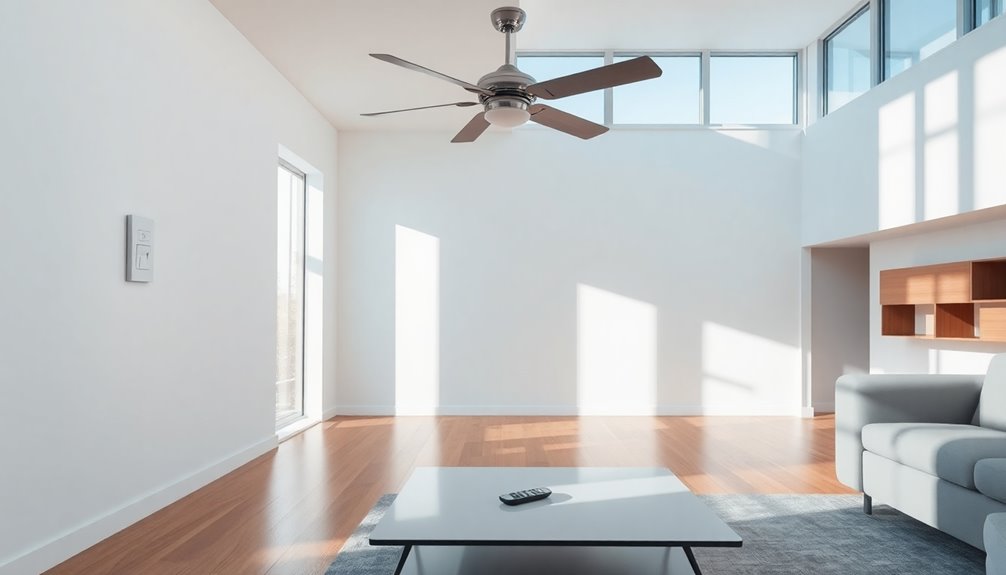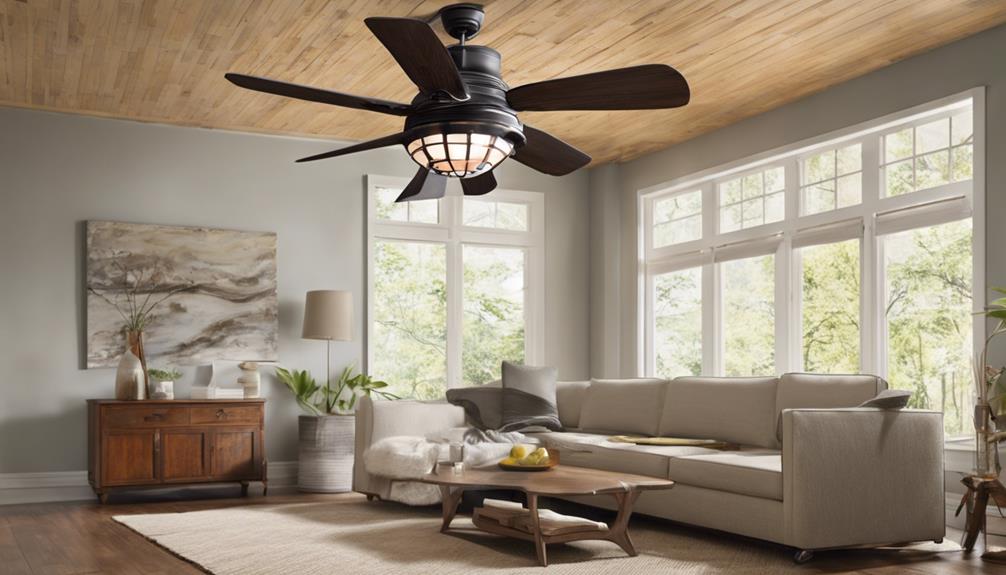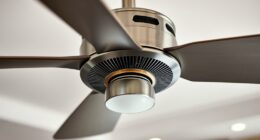You can't install a ceiling fan without proper wiring. Wiring is essential for the fan's safe operation and to guarantee it functions correctly. You'll need to connect three wires: black for hot, white for neutral, and green or bare for ground. If your space lacks existing wiring, it's best to hire a licensed electrician. They can help with the installation and guarantee compliance with local codes. Proper wiring isn't just a recommendation; it's vital for safety. Curious about the installation process and additional tips? There's more that can guide you through getting your ceiling fan up and running smoothly.
Key Takeaways
- A ceiling fan requires proper electrical wiring; it cannot be installed without an electrical source.
- If existing wiring is absent, a licensed electrician must install new wiring for the fan.
- An electrical box must be present to securely mount the ceiling fan and connect wiring.
- Ensure compliance with local building codes when adding new electrical wiring for safety.
- Without wiring, the fan cannot function; proper installation is essential for operational safety.
Understanding Ceiling Fan Requirements

When considering a ceiling fan installation, it's vital to understand its requirements. First, you need to verify that your home has the proper electrical wiring in place. Most ceiling fans require a dedicated circuit and a ceiling box rated to support the fan's weight and motion. This isn't just about aesthetics; it's important for safe and effective operation.
If you're starting from scratch with no existing wiring, hiring a licensed electrician is highly recommended. They can install the necessary wiring to guarantee compliance with safety standards. Most ceiling fans come with three essential wires: black (hot), white (neutral), and green or bare (ground). You'll need to connect these correctly to establish a reliable power supply.
Placement also matters. Make sure to position the fan centrally in the room, keeping it at least 18 inches away from walls to optimize airflow.
If you find yourself needing to install a ceiling fan without existing wiring, be prepared for costs that can reach around $2,000. Understanding these requirements will help you make informed decisions for your ceiling fan installation.
Safety Precautions Before Installation

Making certain safety before installing your ceiling fan is essential to prevent accidents and electrical hazards. Here are some key precautions you should take:
- Turn off the circuit breaker: Before you start any electrical work, make sure to switch off the electricity at the circuit breaker. This step is vital to avoid electrocution.
- Use a voltage tester: Even after turning off the breaker, use a voltage tester to confirm that the wires aren't live. This helps guarantee that you're working in a safe environment.
- Check for proper grounding: Make sure the fan and electrical box are properly grounded. This reduces the risk of electrical shock and guarantees compliance with local electrical codes.
- Consult a licensed electrician: If you're unsure about any aspect of the installation, especially if new wiring is involved, it's best to hire a licensed electrician. Their expertise can prevent safety risks and ensure the installation meets all safety standards.
Choosing the Right Location

When choosing the right location for your ceiling fan, aim for the center of the room to maximize air circulation and comfort.
Make sure there's at least 18 inches of clearance from the nearest wall to prevent obstruction.
Additionally, check for any overhead obstacles that could interfere with the fan's operation.
Optimal Room Centering
Here are some key factors to take into account when selecting the right location for your fan:
- Room Size: Larger rooms may require a bigger fan or multiple fans to guarantee effective airflow distribution.
- Distance from Walls: Confirm that the fan blades are at least 18 inches away from the nearest wall to prevent obstruction and optimize air circulation.
- Power Source: Assess the proximity to an existing power source. This is critical for safe operation and to avoid any wiring complications.
- Ceiling Joists: Use a stud finder to locate ceiling joists, ensuring secure installation and support for the fan's weight, which typically ranges from 15 to 50 pounds.
Additionally, it's important to consider energy-efficient technology when selecting a ceiling fan, as it can contribute to lower energy bills and enhance overall comfort in your space.
Clearance From Obstacles
Choosing the right location for your ceiling fan goes beyond just centering it in the room; clearance from obstacles is key to guaranteeing ideal performance. First, verify your ceiling fan's blades have at least 18 inches of clearance from the nearest wall. This promotes optimal airflow and prevents obstruction.
Avoid placing the fan near furniture or decor that could impede its movement, as this can greatly reduce efficiency.
Next, consider the height of your ceiling. The fan should be installed at least 7 feet above the floor for safe clearance and effective air circulation. Look out for any overhead fixtures or beams that might interfere with the fan's operation, as these can create noise issues and disrupt airflow patterns.
Finally, assess the room's layout. Positioning the fan centrally not only enhances cooling but also guarantees heating benefits are evenly distributed throughout your space.
Installing the Electrical Box

Installing the electrical box is essential for ensuring your ceiling fan operates safely and effectively. To start, you'll need to determine the right location and support for the box. Here's a simple checklist to guide you through the process:
- Locate Joists: Use a stud finder to identify where the joists are and mark the outline for accurate placement.
- Cut a Hole: Carefully cut a hole in the ceiling for the electrical box, taking care not to damage any existing wiring or structures.
- Install Brace and Saddle: If you're working with double joists, install a support brace and secure the box according to the manufacturer's instructions.
- Secure the Electrical Box: For a single joist, you can nail the electrical box directly to it. Make sure it's rated for the fan's weight and motion.
Once you've installed the box, you can proceed with running the wiring. If you need to run new wiring, consider using fish tape to make the process smoother.
Remember to always comply with local building codes for safety!
Running New Wiring

When you're running new wiring for your ceiling fan, safety and compliance are key.
It's often best to hire a professional electrician to guarantee everything meets local codes and standards. This not only protects your home but also gives you peace of mind during installation. Additionally, ensuring proper indoor air quality can enhance the overall comfort of your living space.
Hiring a Professional Electrician
Hiring a licensed electrician for running new wiring can save you time and guarantee your ceiling fan installation meets all safety standards. Attempting to do it yourself might lead to costly mistakes, especially when it comes to your electrical system.
Here are some reasons why hiring a professional is beneficial:
- Expert Assessment: A licensed electrician will evaluate the best path for new wiring, avoiding obstacles and guaranteeing a secure connection to your ceiling fan location.
- Safe Installation: They've the skills to properly install electrical boxes and support braces, accommodating the fan's weight and motion without compromising safety.
- Compliance with Codes: Professionals guarantee that your installation complies with local electrical codes, minimizing safety risks associated with improper wiring.
- Thorough Testing: After completing the job, electricians will test the entire system to confirm proper functionality, guaranteeing everything works correctly before you try to install a remote or use your new fan.
Safety and Compliance Standards
Safety is paramount when running new wiring for a ceiling fan. You must adhere to local electrical codes and standards to guarantee both safety and compliance. It's essential to hire a licensed electrician for your wiring installation. This professional will prevent potential electrical hazards and assure that all connections are made correctly.
The electrical box you choose for mounting the ceiling fan needs to be rated for weight and motion, complying with building regulations. This choice not only supports the fan securely but also aligns with safety practices.
All wiring must be properly secured and insulated to avoid short circuits and reduce fire risks.
Regular inspections of your newly installed wiring and fixtures are recommended to maintain compliance with safety standards and guarantee everything functions correctly over time. These inspections help identify any potential issues before they become serious problems, keeping your home safe and comfortable.
Mounting the Ceiling Fan

Mounting your ceiling fan requires careful attention to confirm it's securely attached and functions effectively. Start by verifying the fan is mounted to a support brace that can handle its weight, which typically ranges from 15 to 50 pounds. Here's a step-by-step guide to help you:
- Locate the Center: Position your ceiling fan near the center of the room for peak airflow, keeping the blades at least 18 inches from the nearest wall to avoid obstructions.
- Use a Stud Finder: Accurately identify the joists in your ceiling with a stud finder. This step is vital for a safe and secure installation—improper mounting can lead to safety hazards.
- Prepare for Installation: If there's no existing fixture, you may need to cut a hole in the ceiling to install a support brace. Always follow local building codes to guarantee compliance.
- Follow Instructions: Refer to the manufacturer's instructions for specific mounting details. Adhering to these guidelines enhances both the performance and longevity of your ceiling fan.
Testing and Maintenance Tips

Testing and maintaining your ceiling fan is essential to guarantee it operates efficiently and lasts for years. Regularly check the functionality by turning the fan on and off, verifying it runs smoothly without wobbling or odd noises.
Here's a quick reference table for testing and maintenance:
| Task | Frequency | Action |
|---|---|---|
| Functionality Testing | Monthly | Turn on/off, listen for noises, check wobbling |
| Cleaning Blades | Every 3 months | Use a damp cloth to remove dust |
| Screw Tightening | Every 6 months | Check and tighten all screws and connections |
Before conducting any maintenance, always use a voltage tester to confirm that the power is off. If you encounter issues, refer to the manufacturer's instructions for troubleshooting steps. If the problem persists, don't hesitate to contact a licensed electrician to verify safety and effective repairs. Regular testing and maintenance can help you avoid larger issues down the road, keeping your ceiling fan running smoothly.
Frequently Asked Questions
How Much Does It Cost to Install a Ceiling Fan Without Existing Wiring?
If you're looking to install a ceiling fan without existing wiring, expect to spend between $1,500 and $2,000.
This cost includes new wiring, a ceiling fan box, and the labor fees from a licensed electrician.
Keep in mind that electrician rates typically start at $150 for the first hour, with additional hours costing up to $100.
The complexity of the job can also greatly impact the overall installation price.
Do You Need an Electrician to Install a Ceiling Fan?
When it comes to installing a ceiling fan, you don't want to cut corners.
Hiring an electrician's definitely a smart move. They've got the expertise to guarantee everything's up to code and working safely.
Plus, they can assess your existing electrical system and handle any complications that might arise.
While it may cost a bit more upfront, you'll save yourself the headache and potential hazards down the line.
It's worth every penny!
How Do I Know if My Ceiling Box Can Support a Fan?
To know if your ceiling box can support a fan, check its rating. It should be marked for fan support and rated for at least 70 pounds.
Use a stud finder to locate the joists and guarantee the box's securely mounted to one. Look for screws holding it in place, as they provide better support.
Inspect the wiring for safety and compliance with local codes to ascertain it can handle the fan's operation.
Do Ceiling Fans Need to Be Hardwired?
Imagine trying to sail a ship without a sturdy hull; it just won't float.
Ceiling fans need to be hardwired to guarantee safety and reliable operation. You'll find that most models come with three wires that connect to your ceiling's corresponding wires.
This setup prevents electrical hazards and keeps your home safe. So, if you want a fan that works well, remember: hardwiring's not just important, it's essential.
Conclusion
To sum up, while you can't install a ceiling fan without wiring, knowing the basics can make the process smoother. Did you know that homes with ceiling fans can save up to 30% on cooling costs? Imagine feeling that invigorating breeze while slashing your energy bills. By following safety precautions and choosing the right location, you can enjoy the comfort and efficiency a ceiling fan brings. Don't forget to test and maintain it for peak performance!









